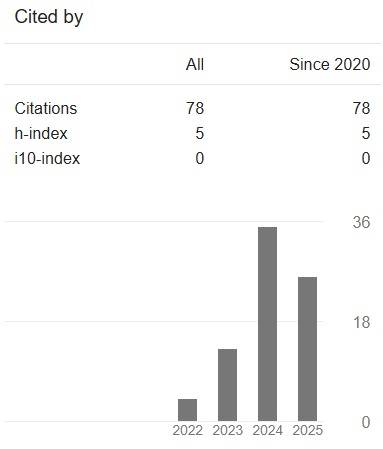Conceptual design evaluation of concurrent brake actuator mechanism
DOI:
https://doi.org/10.24191/jaeds.v1i1.29Abstract
The proper amount of braking force on both wheels is needed to optimize the braking performance and stability of the motorcycle. The braking effectiveness can be maximized by keeping the ideal nonlinear brake force distribution during braking. Thus the purpose of this research is to present a mechanism that can be accommodated as a Concurrent Brake Actuator (CBA) design to control the ideal nonlinear brake force distribution. In this paper, the conceptual design of the CBA mechanism is developed to be used as a based design for CBA development. Thus, two conceptual designs of the CBA mechanism have been generated. The proposed concept designs were evaluated based on Design Failure Mode and Effect Analysis (DFMEA) and SOLIDWORKS Motion Analysis. The potential failure of the CBA concept design was determined based on the risk priority number (RPN) in DFMEA. The information obtained from DFMEA was used in SOLIDWORKS Motion Analysis to identify stress performance analysis for each CBA conceptual design. Then, the best CBA concept design will be selected. The selection was made based on the highest score gained by the CBA concept design in qualitative evaluation. Based on the results, the fixed main body design with a tilted position linear slope in CBA Design I is potentially to actuate and distribute the nonlinear brake force to the front and rear brake with less potential of failure. Therefore, the proposed mechanism design will be used as a based mechanism design for CBA development.
Downloads
References
World Health Organization, “Global Status Report on Road,” 2018.
S. Wannapor, S. Koetniyom, and J. Carmai, “Development and evaluation of advanced seat and helmet for safer motorcycle users,” IOP Conf. Ser. Mater. Sci. Eng., vol. 501, no. 1, 2019, doi: 10.1088/1757-899X/501/1/012015.
M. M. Abdul Manan, A. Várhelyi, A. K. Çelik, and H. H. Hashim, “Road characteristics and environment factors associated with motorcycle fatal crashes in Malaysia,” IATSS Res., vol. 42, no. 4, pp. 207–220, 2018, doi: 10.1016/j.iatssr.2017.11.001.
L. T. Truong, H. T. T. Nguyen, and C. De Gruyter, “Mobile phone use while riding a motorcycle and crashes among university students,” Traffic Inj. Prev., vol. 20, no. 2, pp. 204–210, 2019, doi: 10.1080/15389588.2018.1546048.
K. Ambak, R. Atiq, and R. Ismail, “Intelligent Transports System for motorcycle safety and issues,” Eur. J. Sci. Res., vol. 28, no. 4, pp. 600–611, 2009, Accessed: Oct. 04, 2012. [Online]. Available: http://helibikes.co.uk/Resources/MC Intelligent Transport System.pdf.
A. Jimenez, J. Pablo, R. Zarama, and J. Yerpez, “A case study analysis to examine motorcycle crashes in Bogota , Colombia,” J. Safety Res., vol. 52, pp. 29–38, 2015, doi: 10.1016/j.jsr.2014.12.005.
O. Cherta Ballester et al., “Analysis of trunk impact conditions in motorcycle road accidents based on epidemiological, accidentological data and multibody simulations,” Accid. Anal. Prev., vol. 127, no. January, pp. 223–230, 2019, doi: 10.1016/j.aap.2019.03.006.
D. Atalar and P. Thomas, “Powered two-wheeler crash scenario development,” Accid. Anal. Prev., vol. 125, no. January, pp. 198–206, 2019, doi: 10.1016/j.aap.2019.02.001.
C. Ding, M. Rizzi, J. Strandroth, U. Sander, and N. Lubbe, “Motorcyclist injury risk as a function of real-life crash speed and other contributing factors,” Accid. Anal. Prev., vol. 123, pp. 374–386, 2019, doi: 10.1016/j.aap.2018.12.010.
E. R. Teoh and M. Campbell, “Role of motorcycle type in fatal motorcycle crashes.,” J. Safety Res., vol. 41, no. 6, pp. 507–12, Dec. 2010, doi: 10.1016/j.jsr.2010.10.005.
R. Isermann, R. Mannale, and K. Schmitt, “Collision-avoidance systems PRORETA: Situation analysis and intervention control,” Control Eng. Pract., vol. 20, no. 11, pp. 1236–1246, Jul. 2012, doi: https://doi.org/10.1016/j.conengprac.2012.06.003.
P. Seiniger, K. Schröter, and J. Gail, “Perspectives for motorcycle stability control systems,” Accid. Anal. Prev., vol. 44, no. 1, pp. 74–81, 2012, doi: 10.1016/j.aap.2010.11.018.
Y. T. Lin, C. Y. Tseng, J. H. Kuang, and Y. M. Hwang, “A design method for a variable combined brake system for motorcycles applying the adaptive control method,” Machines, vol. 9, no. 2, pp. 1–18, 2021, doi: 10.3390/machines9020031.
K. Bayar, R. Biasini, S. Onori, and G. Rizzoni, “Modelling and control of a brake system for an extended range electric vehicle equipped with axle motors,” Int. J. Veh. Des., vol. 58, no. 2–4, pp. 399–426, 2012, doi: 10.1504/IJVD.2012.047387.
L. Sun et al., “Influence of methane on hot filament CVD diamond films deposited on high-speed steel substrates with WC-Co interlayer,” Huagong Xuebao/CIESC J., vol. 60, no. 2, pp. 444–449, 2009, doi: 10.1007/s11771.
V. Arakelian and S. Briot, “Simultaneous inertia force/moment balancing and torque compensation of slider-crank mechanisms,” Mech. Res. Commun., vol. 37, no. 2, pp. 265–269, 2010, doi: 10.1016/j.mechrescom.2009.11.007.
P. Kitrungloadjanaporn, A. Phothong, and M. Precharattana, “Seesaw Balancing: A Hands-On Model to Understand Moment of Force in Classroom,” Appl. Mech. Mater., vol. 879, no. March, pp. 269–275, 2018, doi: 10.4028/www.scientific.net/amm.879.269.
R. S. Berkof, “Complete force and moment balancing of inline four-bar linkages,” Mech. Mach. Theory, vol. 8, no. 3, pp. 397–410, Sep. 1973, doi: 10.1016/0094-114X(73)90076-1.
S. Vinodh and D. Santhosh, “Application of FMEA to an automotive leaf spring manufacturing organization,” TQM J., vol. 24, no. 3, pp. 260–274, 2012, doi: 10.1108/17542731211226772.
G. S. Mali, “Novel Escapement Mechanism using a Compliant Mechanism and a Piezoelectric Actuator,” 2007.
Downloads
Published
How to Cite
Issue
Section
License
Copyright (c) 2021 MAHAMAD HISYAM MAHAMAD BASRI, ABDUL HALIM ZULKIFLI, NOOR ISWADI ISMAIL, TALIB RIA JAAFAR, MUHAMMAD ARIF AB HAMID PAHMI, AZMI HUSIN

This work is licensed under a Creative Commons Attribution 4.0 International License.









